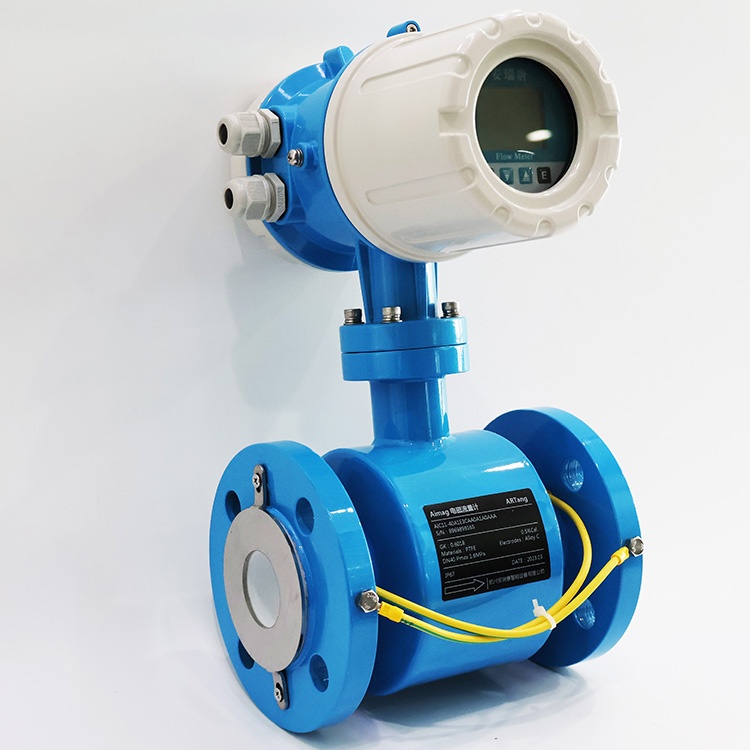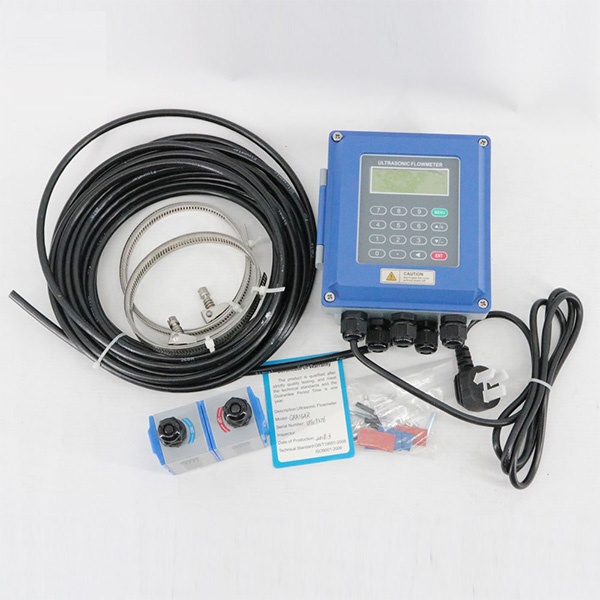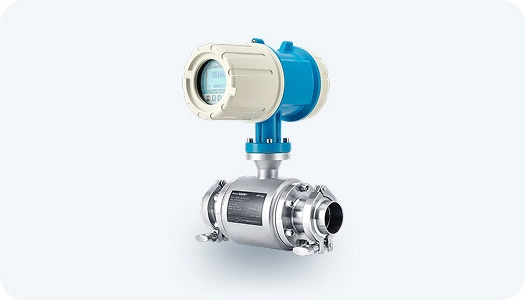-
Date:2025-10-28
-
Page View:150
A magnetic flow transmitter is a flow measurement device for conductive liquids and slurries, designed based on Faraday’s law of electromagnetic induction. It mainly consists of a measuring tube, magnetic circuit system, and electrodes, and is available in integrated and remote versions — the remote type supports installation up to 200 meters away. This device is suitable for industries such as chemical processing, environmental protection, and food production, capable of measuring acidic and alkaline corrosive liquids, slurries, and other high-viscosity media. It features a maximum protection rating of IP68 and a measurement accuracy of ±0.2%.
What is the Working Principle of a Magnetic Flow Transmitter?
A magnetic flow transmitter operates based on Faraday’s law of electromagnetic induction. When a conductive fluid flows through the measuring tube, its electrical conductivity interacts with the magnetic field generated by the electromagnetic coils inside the transmitter. This induces an electromotive force (EMF) proportional to the flow velocity of the fluid. By measuring the induced EMF, the transmitter can accurately determine the flow velocity and volumetric flow rate of the fluid.
Working Principles and Applications of Flow Transmitters
Operates based on Faraday’s law of electromagnetic induction, determining flow rate by measuring the induced electromotive force (EMF) generated as a conductive liquid moves through a magnetic field. It is suitable for measuring conductive liquids.
Measures flow by detecting changes in the propagation speed of ultrasonic waves through the fluid. It is suitable for liquids and gases, especially in large-diameter pipelines and non-contact measurement applications.
Measures flow directly using the Coriolis effect or thermal principles to determine the mass flow rate of the fluid. It is ideal for various types of fluids, particularly in applications that require high measurement accuracy.
Turbine Flow Transmitter:
Determines flow rate based on the rotational speed of a turbine placed in the flow stream. It is applicable to both liquids and gases, offering high precision and fast response.
Differential Pressure Flow Transmitter:
Measures flow by detecting the pressure differential created as fluid passes through a restriction in the pipeline. Common types include orifice plates, Venturi tubes, and nozzles.

Magnetic Flow Transmitter

Ultrasonic Flow Transmitter
Applications of Magnetic Flow Transmitters in Industry
Magnetic flow transmitters offer many advantages that traditional flow meters lack — such as no moving parts, high measurement accuracy, and strong adaptability — making them especially suitable for demanding industrial environments.
Chemical Industry
In the chemical industry, many fluids are corrosive, highly viscous, or contain solid particles, which can damage traditional mechanical flow meters and affect measurement accuracy. Magnetic flow transmitters, however, can operate reliably under harsh conditions, making them ideal for measuring the flow of acidic or alkaline solutions, and chemical reaction liquids. Their non-mechanical design minimizes wear and tear, reduces maintenance costs and downtime, and improves production efficiency.
Food and Beverage Industry
Magnetic flow transmitters are widely used to measure the flow of various liquids such as milk, juice, beer, and other beverages. Since this industry has strict hygiene requirements, the transmitter’s simple design (no moving parts and easy to clean) makes it an excellent choice. Moreover, it is insensitive to changes in liquid viscosity, ensuring stable and precise measurements in all production stages.
Water and Wastewater Treatment
In applications such as municipal water supply and wastewater treatment, magnetic flow transmitters are used for flow monitoring and control. Because the composition of treated water often varies, traditional flow meters may struggle to deliver accurate readings. Magnetic flow transmitters, however, are unaffected by changes in fluid density, temperature, or pressure, ensuring reliable performance in complex conditions and helping maintain efficient water treatment operations.
Energy Industry
Magnetic flow transmitters are also widely used in the energy sector, such as in thermal power plants and heating stations, for measuring the flow of cooling water, steam, and other process fluids. These fluids often exhibit complex flow behaviors, but thanks to the transmitter’s broad fluid compatibility and high precision, it effectively supports energy efficiency monitoring and optimization.
Flow Transmitter Selection
Choosing the right flow transmitter is essential to ensure measurement accuracy and system stability. The following are key factors to consider during selection:
Measured Medium:
Different types of flow transmitters are suitable for different media, such as liquids, gases, or steam. It’s also important to consider the medium’s conductivity, viscosity, and corrosiveness.
Measuring Range:
Determine the required measuring range based on the actual application, and select a transmitter that can effectively cover that range.
Accuracy Requirements:
Choose a flow transmitter with accuracy that meets your application’s needs. Industries such as pharmaceuticals and chemicals typically require high-precision measurement.
Operating Environment:
Consider environmental conditions such as temperature and pressure. Select a transmitter that can operate reliably and durably under those specific conditions.
Installation Method:
Different types of flow transmitters offer different installation methods, such as inline, insertion, or clamp-on. Choose the method that best fits the site conditions.
Output Signal:
Select the appropriate output signal type based on your system’s interface requirements, such as 4–20mA, 0–10V, or pulse output.










